Jim Collins rocked the business world in 2001 with his mega-hit GOOD TO GREAT, and we rocked the world with our visual summary of it. A few years later he came along with another killer question: how come some thrive in chaotic circumstances? And clearly, others don’t. A super relevant questions, especially since the world is ever more chaotic. VUCA, anyone?
Fear not, dear surfer, here comes the visual summary. Five neat pictures unpack the core contents of Great by Choice, by Jim Collins. Uncertainty, Chaos, and Luck–Why Some Thrive Despite Them All.
The Big Question
Why do some people thrive, even in VUCA circumstances. Risk, change, uncertainty and chaos is threatening. Normal plans seem to not work as conditions always change. Many don’t make it. But some thrive. What is going out? What is their secret sauce?
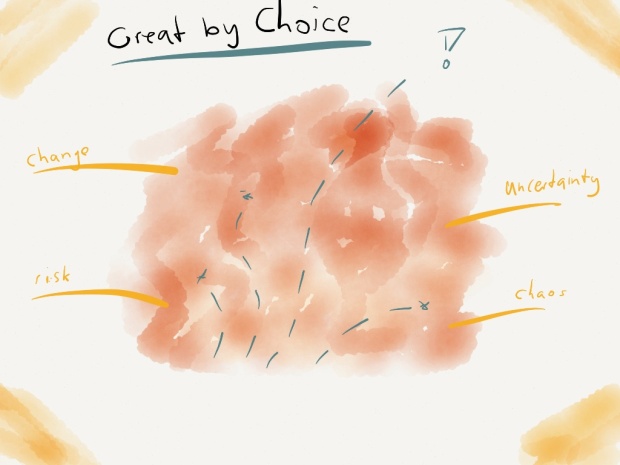
10xers
Early in the book, Jim Collins shares the comparison of two south pole pioniers. In 1911, two explorers and their teams made one of the most challenging trips to unknown territory. Roald Amundsen vs. Robert Scott. One made it, the other died. What set them apart? Jim Collins develops his idea of “10x”ers. Teams that make it in tough conditions. Teams that are the best of the best. He finds companies that beat the average by 10 times – and the reasons are similiar to the approach of Amundsen on the South Pole. These companies in his studies are Amgen, Biomet, Intel, Microsoft, Progressive Insurance, Southwest Airlines and Stryker.
The 10xers have a set of attitudes that keep them not only going, but beating the odds and delivering stunning performance. They follow a fanatical discipline that keeps them on track. They posesses empirical creativity that keeps them vibrant. They are driven by a productive paranoia that keeps them alive. And they show Level 5 ambition (see good to great for summary) that guides their motivation. Let’s explore those…
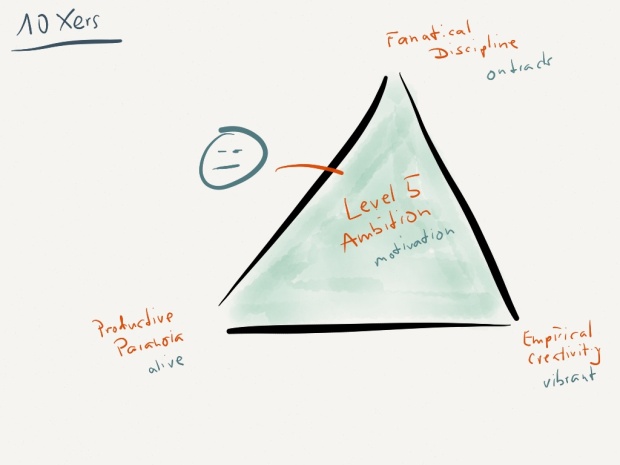
20 Mile March
Amundsen’s team displayed a stunning discipline. They marched 20 miles every day on their way to the South Pole, rain or shine. This steady pace kept them from overpacing or slacking. It instilled in them a self-confindence to perform in the face of adversity, it reduced the likelihood of catastrophe and it gave them contril in an out-of-control environment.
On the other hand, Scott’s team had a wide fluctuation in pace and reach. That exposed them to danger and risk – which eventually killed them. So, the fanatical displine is one of the ingredients to thrive in chaos and stay on track.
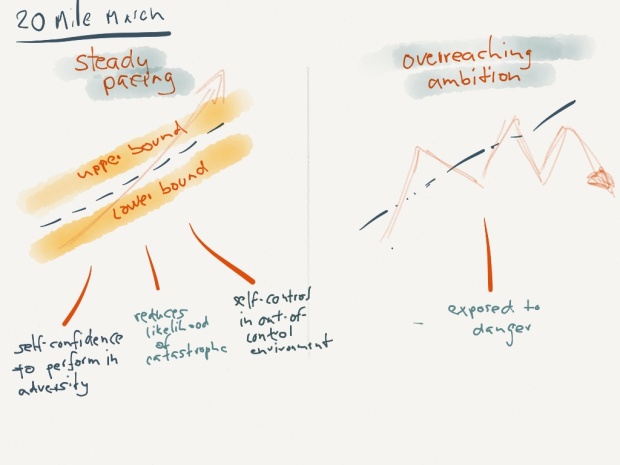
Fire bullets, not cannon balls
Jim Collins noted next how many companies (as the Scott team in the expedition) tend to make big bets on getting results. He calls that “firing cannon balls”. For companies, this might be big product developments, huge investments or big marketing pushes. Those are all-in approaches that carry high risks, high cost and take much attention.
On the contrary, the smart approach is to first fire bullets – small bets. They allow you to test, evalute and calibrate. Once you have found your mark, then go ahead with cannon firing. The thrivers in the chaotic world have an empirical creativity that guides their target setting and keeps them relevant.
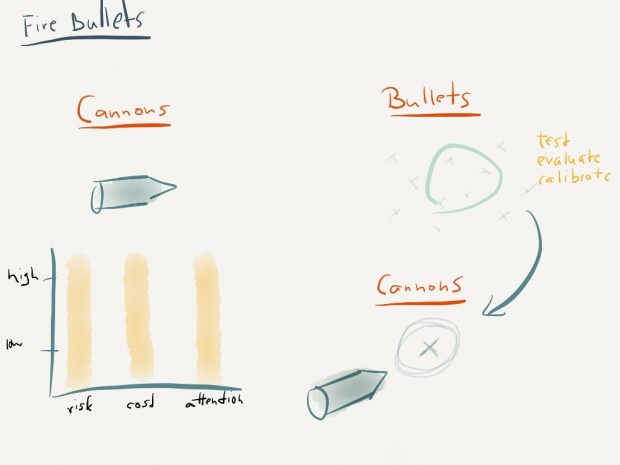
Lead above the death line
In order to stay alive, you have to avoid death. Simple. 10xers know that they cannot predict future events – so they prepare obsessively, ahead of time, all the time. They know that bad events can come, and then come quick and in succession. So, buffers and shock absorbers are introduced that help them withstand setbacks and push on. Specifically, the show a productive paranois that…
- builds cash reserves. They act like oxygen canisters to help them stay alive when bad events unfold.
- limit risks. They avoid risks that could wipe them out in one stroke, analyze and resist assymetrical risk (where downside is great than the upside) and try to stay away from situations that are beyond their ability to act.
- zoom in, then zoom out. They narrow in on plans and execution to act prudent and clear; at the same time the step back to take a look at the big picture and see trends and changes.
So, the Thrivers took less risks and were more concerned with bad events than the others. That productive paranois helped them stay alive and pull ahead over the long term.
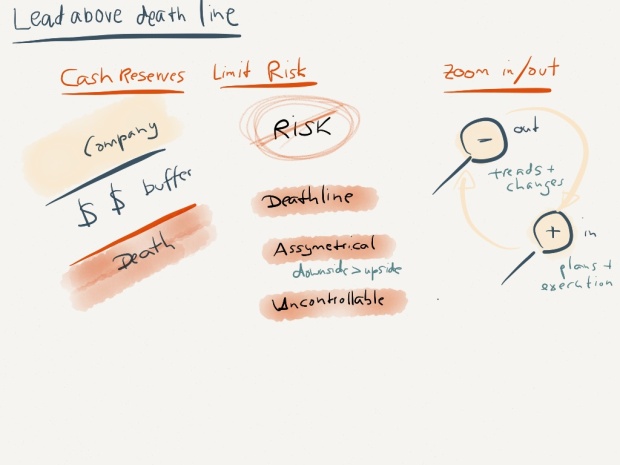
Simple Recipes
One more great idea of this study. The more chaotic the circumstances, the better are simple guides. Jim Collins introduces SMAC Recipes – simple, methodical and consistent practices that guide you. A SMAC recipe is a list of up to 10 guidelines that unify your efforts and can be relied on (because they are empirically tested) in tough times. A SMAC recipe reflects empirical validation and insight about what actually works and why.
Developing a SMaC recipe, adhering to it, and amending it (rarely) when conditions merit correlate with 10X success. This requires the three 10Xer behaviors: empirical creativity (for developing and evolving it), fanatic discipline (for sticking to it), and productive paranoia (for sensing necessary changes). Here is an exerpt:
Let’s look at an example from 1979 Southwest Airlines and Howard Putnam’s 10 points of their SMaC:
- Remain a short-haul carrier, under two-hour segments.
- Utilize the 737 as our primary aircraft for ten to twelve years.
- Continued high aircraft utilization and quick turns, ten minutes in most cases.
- The passenger is our #1 product. Do not carry air freight or mail, only small packages which have high profitability and low handling costs.
- Continued low fares and high frequency of service.
- Stay out of food services.
- No interlining … costs in ticketing, tariffs and computers and our unique airports do not lend themselves to interlining.
- Retain Texas as our #1 priority and only go interstate if high-density short-haul markets are available to us.
- Keep the family and people feeling in our service and fun atmosphere aloft. We’re proud of our employees.
- Keep it simple. Continue cash-register tickets, ten-minute cancellation of reservations at the gate in order to clear standbys, simplified computer system, free drinks in Executive service, free coffee and donuts in the boarding area, no seat selection on board, tape-recorded passenger manifest, bring airplanes and crews home to Dallas each night, only on domicile and maintenance facility.
Note that #4-6 are about not doing things versus doing something. Often times what we don’t do is as important as what we do. Less is more is not just a good axiom for priorities. It’s ideal for building a business. You can’t be good at everything.
Choosing what not to do so you can concentrate on what you are extremely good at separates you from your competition. It also tells your customer what you are good at opening up a whole range of promises that you can deliver to differentiate yourself from your competitor.
Conclusion
Great by Choice is another killer book. While managing risk might not strike you as particularly innovative insight, it fits well within the context of change. We all know that the world is a dynamic arena where we sometimes wake up to shocking changes. Jim Collins gives us some good and solid advice on which attitudes while give us stability and long-term growth.